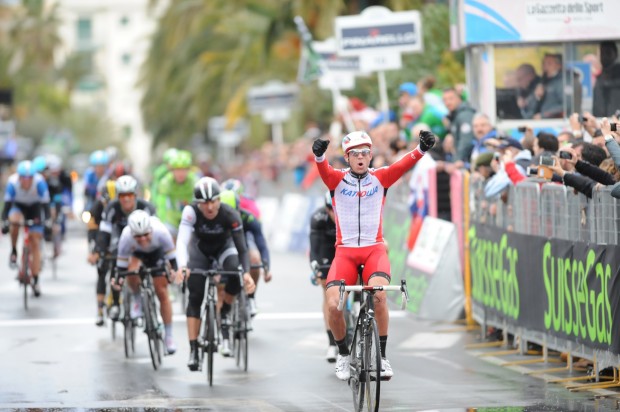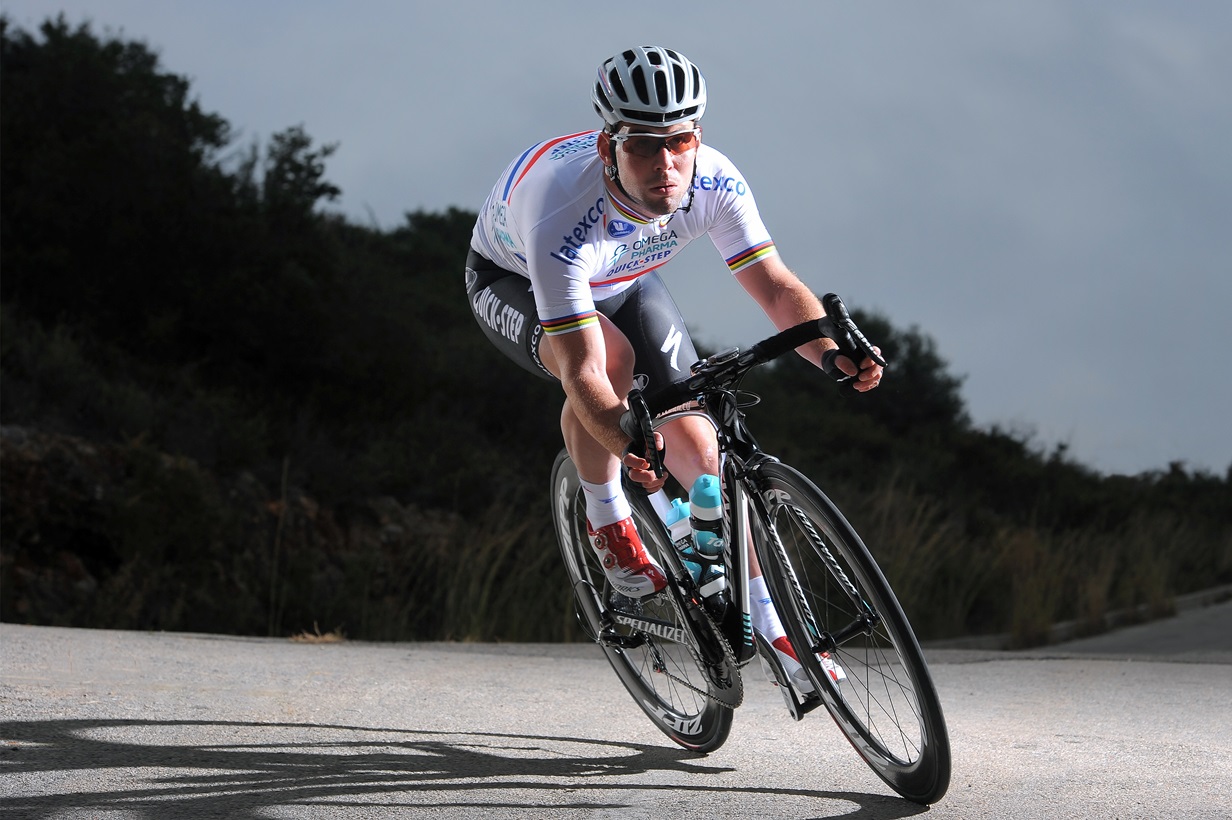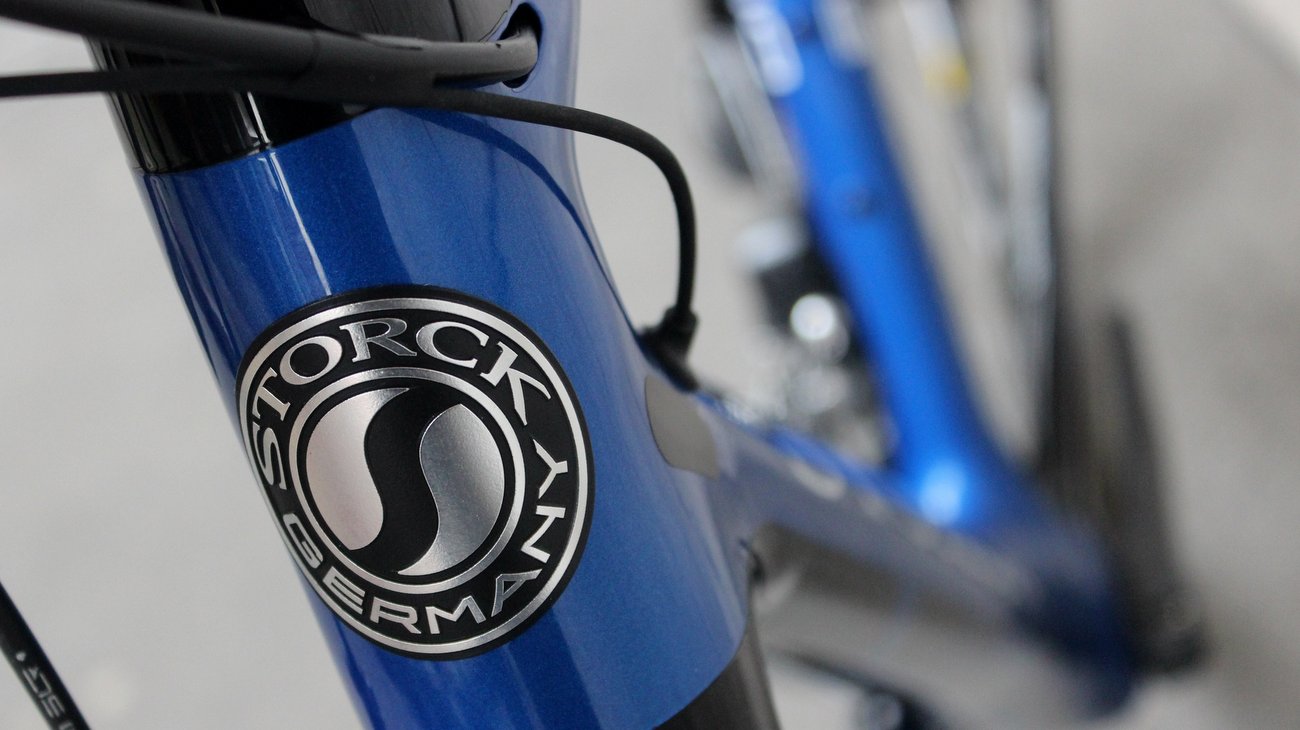Alexander Kristoff (Katusha) has won the 2014 Milan-San Remo.
The Norwegian triumphed in a bunch finish at the end of a grueling and rain-hit race of nearly 300km.
Britain’s Ben Swift (Team Sky) finished third, pipped on the line by 2008 champion, Fabian Cancellara (Trek). Juan Jose Lobato (Movistar) was fourth, one place ahead of British champion, Mark Cavendish (Omega Pharma-Quickstep), who won the race in 2009.

“I feel great,” Kristoff said immediately after the race. “It was a fantastic victory. Luca [Paolini, team-mate] helped me a lot in the final.
“I didn’t really believe it until I crossed the line that I had won San Remo. I thought maybe a top 10 finish [was possible]. To win is unbelievable.”
All of the pre-race favourites were present in an elite leading group that descended the Poggio at terrifying speeds in treacherous conditions after nearly seven hours of racing.
Cavendish was the first of the quick men to blink, but appeared to realise almost immediately that he had attacked too soon. Cancellara, second for the third time at San Remo, pounded his handlebars in frustration as he crossed the line behind Kristoff, while Swift can look back with pride on arguably the finest performance of his career.
The race in detail
Steady rain characterised the final 100km of this 105th edition of La Primavera after a hail storm on the Turchino Pass. A six-man break remained ahead after 200km. Nathan Haas (Garmin-Sharp), Matteo Bono (Lampre-Merida), Jan Barta (NetApp-Endura), Marc de Maar (United-Healthcare), Antonio Parrinello (Andrioni), and Maarten Tjallingii (Belkin) rode clear after just 15km with Nicola Boem (Bardiani), who was later dropped.
With 85km remaining, the rain worsened, and while the break continued to work together effectively, the peloton pursued them with an intensity that suggested their time at the fore would be limited. Cannondale and Giant-Shimano drove the bunch, and five kilometres later, the gap had been reduced to 6.30.
The effect of the dismal weather conditions could be seen on several of the riders, many of whom whirled their arms in a bid to stay warm. Cancellara was one of many who dropped back to the team car for advice and refreshment.
A stalemate ensued for the next 15km, with the peloton’s impetus blunted by the need of many of the riders to pull on rain capes, and the riders in the breakaway temporarily concentrated on taking on food.
By the time the peloton reached Alassio, with 55km remaining, the leading group had been reduced to four riders, with Parrinello and Haas, the latter suffering a puncture, shelled from the breakaway.
As they passed through the costal town of Laiguella, Cannondale massed on the front of the bunch, while Paolini (Katusha), one of the pre-race favourites, rode at the rear. TV pictures showed the Italian emptying a bidon of hot tea over his fingers. Cavendish meanwhile shivered in the centre of the bunch, surrounded by a phalanx of team-mates.
Peloton’s capos lead the way over the Tri Capi
The Capo Mele, reached with 50km remaining, offered the first danger and Tjallingii took no chances, putting in an extended turn to remain at the head of the breakaway. Cavendish moved to the front of the group on the climb, despite suffering with the cold: a TV close-up showed his teeth chattering.
The Manx Missile’s sprint rival, Andre Greipel (Lotto-Belisol), not a noted climber, remained on Cavendish’s shoulder on the ascent of the Capo Cervo, while Cannondale continued to drive the bunch. Katusha sent numbers to the front, perhaps riding for the tea-stained Paolini.
Katusha took it up again on the climb of the Capo Berta, with Cavendish tucked just behind them, and Peter Sagan (Cannondale), strongly tipped to win his first Monument, on his elbow. The sudden expression of interest from the peloton reduced the lead of the breakaway to below four minutes for the first time. Of the men in front, Barta’s suffering was the greatest. The 29-year-old Czech cracked as Tjallingii continued to set the pace.
With 38km remaining, and six hours in the saddle, Cancellara and Vincenzo Niabli (Astana) moved to the front. Up ahead, the gap dropped to below three minutes, and the three remaining breakaway riders – de Maar, Bono, and Tjallingii – pressed on bravely.
The trio coped better with the rain-slicked descents that led to the climb of the Cipressa, which fractured the bunch. All the major players, however, remained in a significantly reduced peloton, including Cavendish. Katusha continued to lead the bunch as it passed beneath the 30km to go kite.
Tjallingii remained at the head of the breakaway as the three men hit the lower slopes of the Cipressa. Bono swiftly unhitched, while de Maar clung on grimly to the Belkin rider’s wheel. Lotto Belisol took up a position en masse at the head of the chasing bunch, and were swiftly joined by Giant-Shimano. Their combined efforts reduced the lead of the breakaway to below two minutes for the first time.
Peter Sagan’s green team were the next to take up a position at the head of the bunch. Not content with setting the pace, Sagan’s team-mate, Alessandro De Marchi, offered a vicious acceleration, with his team-leader on his wheel, as the Cipressa unfolded. Swift glued himself to Sagan’s wheel, but the Yorkshireman’s team leader, Edvald Boasson Hagen, was nowhere in sight.
The shark bites
Nibali detonated the race as the summit of the Cipressa loomed, and passed Bono with ease. Despite frequent checks over his shoulder, none of the favourites responded to his acceleration. De Marchi continued to set tempo for Sagan, but no one attempted a bridge to the Giro d’Italia champion, who crested the climb with a 24-second advantage over the elite chasing bunch.
With 23km remaining, Nibali had reduced the advantage of de Maar and Tjallingii to just 16 seconds. The Italian produced a descending masterclass, pedaling through the very tight corners of the Cipressa, despite the treacherous conditions.
The Italian swept past the two long-term leaders on the descent, shattering the preconceptions of those who imagined he might rely on the combined efforts of a three-man break to reach the Poggio. Once off the slopes of the Cipressa, he assumed a time trial position and began his solo bid for victory.
Perhaps belatedly sensing the seriousness of Nibali’s attack, Cancellara and a group of about five companions, including Omega Pharma-Quickstep’s Zdenek Stybar, chipped off the front, sparking panic among a peloton reduced to about 30 riders.
De Marchi continued his seemingly endless turn on the front to snuff out the danger and reunite the elite group, which contained Greipel and the still-game Swift, who rode at third wheel in pursuit of Nibali and Tjallingi.
Boasson Hagen made his first appearance at the sharp end of the bunch as it passed beneath the 14km to go kite, fastening himself onto the wheel of Swift. BMC Racing’s Greg Van Avermaet, a renowned Classics hardman who finished second to Britain’s Ian Stannard by the narrowest of margins at the Omloop Het Niewsblad, joined the work of the bunch, among whom there appeared to be a growing realisation that Nibali’s advantage could prove decisive if left unchecked.
Prepare for the Poggio
‘The Shark’ gobbled up the kilometres between the Cipressa and the Poggio and began the ascent of the latter alone. Almost inevitably, De Marchi led the chasing group through the final left hander and onto the Poggio, and within seconds they passed the brave Tjallingi.
Swift took up the pace making as De Marchi finally fell aside, leading a line of heavyweight contenders that contained Greipel, Cavendish, Cancellara, Sagan, Philippe Gilbert (BMC Racing), and defending champion, Gerald Ciolek (MTN-Qhebeka). Sky had numbers in the lead group, and when Swift tired, Salvatore Puccio moved to the front.
Nibali had a 13-second advantage in his pocket as he turned into the famed right-hander that marks the entrance to the most challenging reaches of the Poggio. Greipel and Cavendish took up positions at the head of the chasing group, braced for the attacks of the Classics specialists.
Gregory Rast (Trek Factory Racing) was the first to bridge to Nibali, and rode straight past the Italian. The Swiss played a role in softening the field for Cancellara, but was soon passed by Giro stage winner, Enrico Battaglin (Bardiani-Valvole). Rast hung on grimly as the summit of the Poggio loomed, but frequent looks over his shoulder suggested he was uncertain whether to accompany the Italian or drop back to his countryman and team leader.
If Rast was uncertain, Battaglin was free from any such doubts, and with just 7.5km remaining, the pair had eked out a lead of 20 seconds, forged almost entirely by the Italian’s efforts. Rast merely sat on his wheel.
Gilbert launched his own attack, but the 2013 world road race champion was pegged almost immediately by Daniele Benatti (Tinkoff-Saxo). Gilbert’s effort, however, was sufficient to reel in Battaglin and Rast.
Paolini was next to hit the front, and his pace was enough to shell Boasson Hagen from the back of the group, while up ahead Bauke Molema (Belkin), threw himself into the high-speed descent, with Van Avermaet on his wheel.
What goes up…
The peloton’s best descenders were forced to show their very best descending skills, and Cavendish, who frequently claims that his descending talents in Grand Tours are missed by the television cameras, showcased his abilities.
With a kilometre of the descent remaining, the leading pair were caught. Van Avermaet launched an immediate counter attack, but was unable to shake his pursuers. As the road flattened, Mollema attacked again, but was immediately passed by Sonny Colbrelli (Bardiani-Valvole).
The Italian’s moment of glory ended within a couple of hundred meters, however, and with 1.8km remaining the group came back together, and were joined by Greipel, who had made up lost ground on the descent of the Poggio.
Katusha led the leaders under the flamme rouge, with Ciolek, Cavendish, Sagan, Cancellara, and Greipel all present. A crash shed some of the riders, but all the heavyweights survived the twisting section through town.
As the road straightened, Cavendish launched early, but faded in sight of the line, and was passed by Kristoff, who joins an elite club of riders to win La Primavera.
Milan-San Remo 2014 – result
1) Alexander Kristoff (NOR) – Katusha – 6.55.56
2) Fabian Cancellara (SUI) – Trek – ST
3) Ben Swift (GBR) – Team Sky
4) Juan Jose Lobato (ESP) – Movistar
5) Mark Cavendish (GBR) – Omega Pharma-Quickstep
6) Sonny Colbrelli (ITA) – Bardiani-Valvole
7) Zdenek Stybar (CZE) – Omega Pharma-Quickstep
8) Sacha Modolo (ITA) – Lampre-Merida
9) Gerald Ciolek (GER) – MTN-Qhebka
10) Peter Sagan (SVK) – Cannondale





